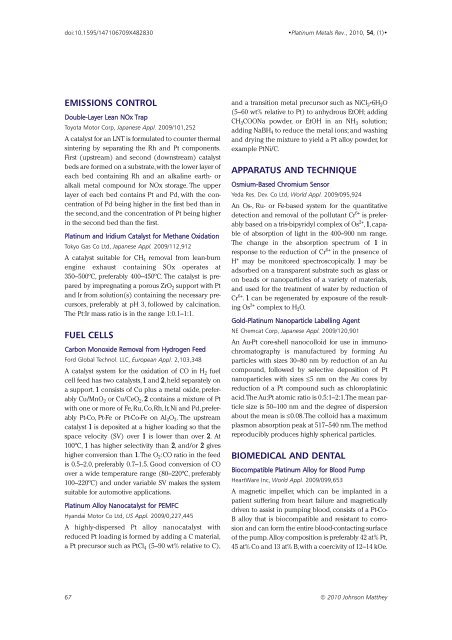Download Issue PDF - Platinum Metals Review
Download Issue PDF - Platinum Metals Review
Download Issue PDF - Platinum Metals Review
You also want an ePaper? Increase the reach of your titles
YUMPU automatically turns print PDFs into web optimized ePapers that Google loves.
doi:10.1595/147106709X482830<br />
•<strong>Platinum</strong> <strong>Metals</strong> Rev., 2010, 54, (1)•<br />
EMISSIONS CONTROL<br />
Double-Layer Lean NOx Trap<br />
Toyota Motor Corp, Japanese Appl. 2009/101,252<br />
A catalyst for an LNT is formulated to counter thermal<br />
sintering by separating the Rh and Pt components.<br />
First (upstream) and second (downstream) catalyst<br />
beds are formed on a substrate,with the lower layer of<br />
each bed containing Rh and an alkaline earth- or<br />
alkali metal compound for NOx storage. The upper<br />
layer of each bed contains Pt and Pd, with the concentration<br />
of Pd being higher in the first bed than in<br />
the second, and the concentration of Pt being higher<br />
in the second bed than the first.<br />
<strong>Platinum</strong> and Iridium Catalyst for Methane Oxidation<br />
Tokyo Gas Co Ltd, Japanese Appl. 2009/112,912<br />
A catalyst suitable for CH 4 removal from lean-burn<br />
engine exhaust containing SOx operates at<br />
350–500ºC, preferably 400–450ºC. The catalyst is prepared<br />
by impregnating a porous ZrO 2 support with Pt<br />
and Ir from solution(s) containing the necessary precursors,<br />
preferably at pH 3, followed by calcination.<br />
The Pt:Ir mass ratio is in the range 1:0.1–1:1.<br />
FUEL CELLS<br />
Carbon Monoxide Removal from Hydrogen Feed<br />
Ford Global Technol. LLC, European Appl. 2,103,348<br />
A catalyst system for the oxidation of CO in H 2 fuel<br />
cell feed has two catalysts, 1 and 2,held separately on<br />
a support. 1 consists of Cu plus a metal oxide, preferably<br />
Cu/MnO 2 or Cu/CeO 2 . 2 contains a mixture of Pt<br />
with one or more of Fe,Ru,Co,Rh,Ir,Ni and Pd,preferably<br />
Pt-Co, Pt-Fe or Pt-Co-Fe on Al 2 O 3 . The upstream<br />
catalyst 1 is deposited at a higher loading so that the<br />
space velocity (SV) over 1 is lower than over 2. At<br />
100ºC, 1 has higher selectivity than 2, and/or 2 gives<br />
higher conversion than 1.The O 2 :CO ratio in the feed<br />
is 0.5–2.0, preferably 0.7–1.5. Good conversion of CO<br />
over a wide temperature range (80–220ºC, preferably<br />
100–220ºC) and under variable SV makes the system<br />
suitable for automotive applications.<br />
<strong>Platinum</strong> Alloy Nanocatalyst for PEMFC<br />
Hyandai Motor Co Ltd, US Appl. 2009/0,227,445<br />
A highly-dispersed Pt alloy nanocatalyst with<br />
reduced Pt loading is formed by adding a C material,<br />
a Pt precursor such as PtCl 4 (5–90 wt% relative to C),<br />
and a transition metal precursor such as NiCl 2·6H 2 O<br />
(5–60 wt% relative to Pt) to anhydrous EtOH; adding<br />
CH 3 COONa powder, or EtOH in an NH 3 solution;<br />
adding NaBH 4 to reduce the metal ions; and washing<br />
and drying the mixture to yield a Pt alloy powder, for<br />
example PtNi/C.<br />
APPARATUS AND TECHNIQUE<br />
Osmium-Based Chromium Sensor<br />
Yeda Res. Dev. Co Ltd, World Appl. 2009/095,924<br />
An Os-, Ru- or Fe-based system for the quantitative<br />
detection and removal of the pollutant Cr 6+ is preferably<br />
based on a tris-bipyridyl complex of Os 2+ ,1,capable<br />
of absorption of light in the 400–900 nm range.<br />
The change in the absorption spectrum of 1 in<br />
response to the reduction of Cr 6+ in the presence of<br />
H + may be monitored spectroscopically. 1 may be<br />
adsorbed on a transparent substrate such as glass or<br />
on beads or nanoparticles of a variety of materials,<br />
and used for the treatment of water by reduction of<br />
Cr 6+ . 1 can be regenerated by exposure of the resulting<br />
Os 3+ complex to H 2 O.<br />
Gold-<strong>Platinum</strong> Nanoparticle Labelling Agent<br />
NE Chemcat Corp, Japanese Appl. 2009/120,901<br />
An Au-Pt core-shell nanocolloid for use in immunochromatography<br />
is manufactured by forming Au<br />
particles with sizes 30–80 nm by reduction of an Au<br />
compound, followed by selective deposition of Pt<br />
nanoparticles with sizes ≤5 nm on the Au cores by<br />
reduction of a Pt compound such as chloroplatinic<br />
acid.The Au:Pt atomic ratio is 0.5:1–2:1.The mean particle<br />
size is 50–100 nm and the degree of dispersion<br />
about the mean is ≤0.08.The colloid has a maximum<br />
plasmon absorption peak at 517–540 nm.The method<br />
reproducibly produces highly spherical particles.<br />
BIOMEDICAL AND DENTAL<br />
Biocompatible <strong>Platinum</strong> Alloy for Blood Pump<br />
HeartWare Inc, World Appl. 2009/099,653<br />
A magnetic impeller, which can be implanted in a<br />
patient suffering from heart failure and magnetically<br />
driven to assist in pumping blood, consists of a Pt-Co-<br />
B alloy that is biocompatible and resistant to corrosion<br />
and can form the entire blood-contacting surface<br />
of the pump. Alloy composition is preferably 42 at% Pt,<br />
45 at% Co and 13 at% B,with a coercivity of 12–14 kOe.<br />
67 © 2010 Johnson Matthey
















